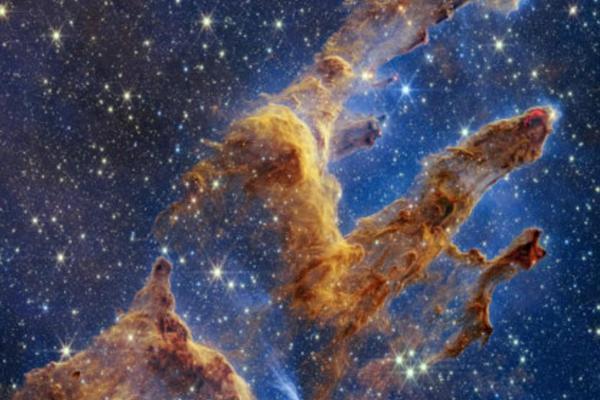Iconic ‘Pillars of Creation’ captured in new Webb image
WASHINGTON


The James Webb Space Telescope captured the iconic “Pillars of Creation,” huge structures of gas and dust teeming with stars, NASA said on Oct. 19, and the image is as majestic as one could hope.
The twinkling of thousands of stars illuminates the telescope’s first shot of the gigantic gold, copper and brown columns standing in the midst of the cosmos.
At the ends of several pillars are bright red, lava-like spots. “These are ejections from stars that are still forming,” only a few hundred thousand years old, NASA said in a statement.
These “young stars periodically shoot out supersonic jets that collide with clouds of material, like these thick pillars,” the US space agency added.
The “Pillars of Creation” are located 6,500 light years from Earth, in the Eagle Nebula of our Milky Way galaxy.
The pillars were made famous by the Hubble Space Telescope, which first captured them in 1995 and then again in 2014.
But thanks to Webb’s infrared capabilities, the newer telescope, launched into space less than a year ago, can peer through the opacity of the pillars, revealing many new stars forming.
“By popular demand, we had to do the Pillars of Creation” with Webb, Klaus Pontoppidan, the science program manager at the Space Telescope Science Institute, said Wednesday on Twitter.
STScI operates Webb from Baltimore, Maryland.
“There are just so many stars!” Pontoppidan added.
NASA astrophysicist Amber Straughn summed it up: “The universe is beautiful!” she wrote on Twitter.
The image, covering an area of about eight light years, was taken by Webb’s primary imager NIRCam, which captures near-infrared wavelengths, invisible to the human eye.
The colors of the image have been “translated” into visible light.
According to NASA, the new image “will help researchers revamp their models of star formation by identifying far more precise counts of newly formed stars, along with the quantities of gas and dust in the region.”
